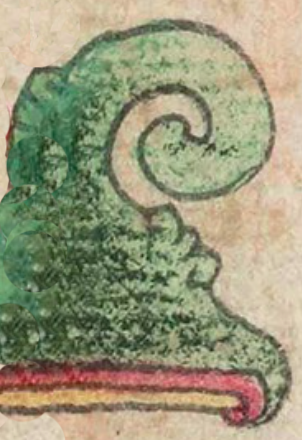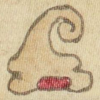Colhuacan (Mdz2r)
This simplex glyph for the place name Colhuacan (also spelled Culhuacan) features a hill or mountain that has a curling, twisted, or bent peak. Other than that, the mountain has the typical two-tone green, semi-bell shape, with curling edges representing rocky outcropping that reinforce the "te-" start to "tepetl" (hill or mountain. The two horizontal red and yellow stripes at the base of the mountain are also standard features of mountain glyphs. In this view, the left side of the mountain glyph is cut away because there was a conquest glyph (tepehualiztli) overlapping with the place glyph, and we removed the conquest glyph.
Stephanie Wood
Scholars have interpreted this place glyph as the place of the Colhua people. The root of Colhua appears to be colli, which can refer to ancestors or to something bent or twisted. The -hua- is a suffix added to nouns that indicates possession. So, perhaps the place name refers to the people who have ancestors, but the visual of a bent-top mountain is meant to provide a phonetic indicator that points to the "col-" of ancestry. Certainly, the Colhua were an early people in the southern end of Valley of Mexico.
John Montgomery made a drawing of the Colhuacan glyph he cites as Boturini 20, which is useful here for making comparisons.
Stephanie Wood
colhuacan.pueblo.
Colhuacan, pueblo
Stephanie Wood
by 1553 at the latest
Stephanie Wood
mountains, hills, montañas, cerros, torcido, twisted, nombres de lugares

col(li), a bent or twisted thing, https://nahuatl.wired-humanities.org/content/colli-1
coltic, curved, https://nahuatl.wired-humanities.org/content/coltic
-hua- (possessor suffix), https://nahuatl.wired-humanities.org/content/hua
-can (locative suffix), where, https://nahuatl.wired-humanities.org/content/can-2
"Place of the Colhua" (apparently agreeing with Berdan and Anawalt) [Frances Karttunen, unpublished manuscript, used here with her permission.]
"Place of the Colhua" (Berdan and Anawalt, 1992, vol. 1, p. 180)
"Donde La Gente Tiene Ancestros" o "Lugar de los Colhua"
Stephanie Wood
Codex Mendoza, folio 2 recto, https://codicemendoza.inah.gob.mx/inicio.php?lang=english
Original manuscript is held by the Bodleian Libraries, University of Oxford, MS. Arch. Selden. A. 1; used here with the UK Creative Commons, “Attribution-NonCommercial-ShareAlike 3.0 License” (CC-BY-NC-SA 3.0)




